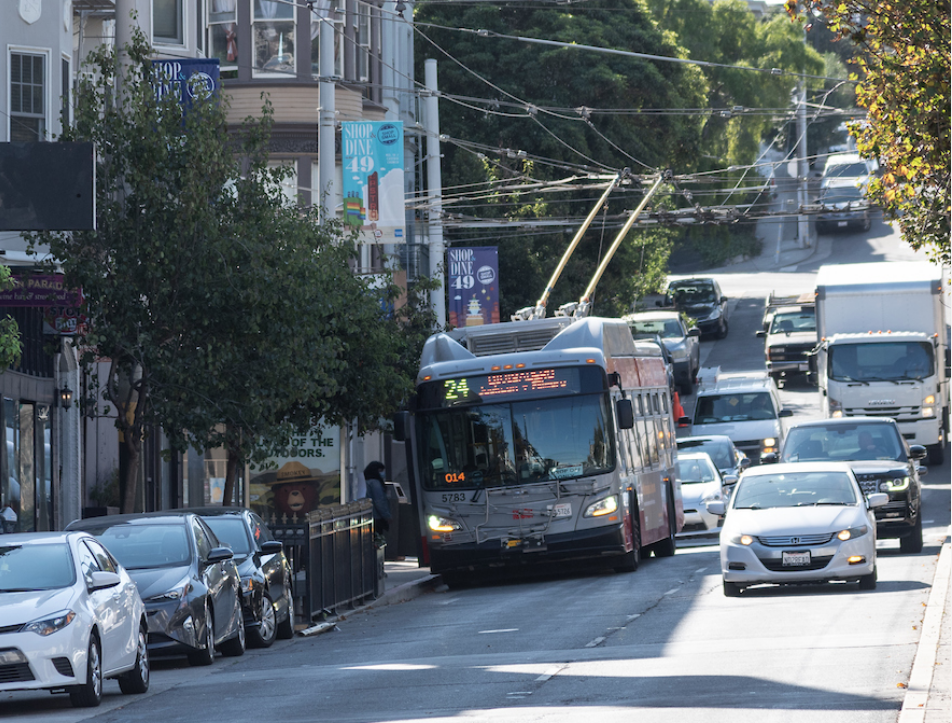Op-ed: The Path Forward for Muni
1:40 PM PDT on August 3, 2021

A 24 on Divis. Image: SFMTA
Note: GJEL Accident Attorneys regularly sponsors coverage on Streetsblog San Francisco and Streetsblog California. Unless noted in the story, GJEL Accident Attorneys is not consulted for the content or editorial direction of the sponsored content.
The contentious debate over the future of Muni has reached fever pitch, culminating last Friday with a special hearing on Muni service restoration. Supervisors Preston and Chan demanded to know why full pre-pandemic service hours couldn’t be restored immediately and insinuated that a secret decision has already been made to abandon large numbers of Muni lines. For his part, Director Tumlin simply repeated his claim that neither the money nor the staff is available to restore service faster than the pace planned by the agency.
It is understandable that Director Tumlin is cautious about restoring service hours too quickly. SFMTA’s financial situation was in a bad state even before the pandemic and is now at a crisis point, with a slow downtown recovery continuing to create financial uncertainty, and the need to rehire a workforce decimated by the pandemic. However, it’s also not acceptable for riders to have to wait until the end of 2022 for Muni to be restored to its pre-pandemic level of service.
Fortunately, there is a strategy to improve service beyond the zero-sum game of deciding where to allocate a limited number of service hours, and without waiting for SFMTA to be fully staffed and funded. It’s a strategy that neither Director Tumlin nor the supervisors have been sufficiently focused on.
Although we may be limited in the number of service hours (i.e. time our bus operators spend behind the wheel) we can deliver, we can achieve more service miles (i.e. distance covered by our buses) by deploying transit only lanes and other transit priority treatments to speed up bus service throughout the city. As well as reducing journey times, getting buses through their runs quicker allows for more bus runs to be made each day with the same number of service hours.
At the start of the pandemic a large number of Temporary Emergency Transit Lanes were planned for major transit corridors across the city, but implementation has stalled with the network far from complete. Planned transit lanes on Divisadero with potential travel time savings of 30% were cancelled because the curb lanes are too narrow - and yet, somehow wide enough for the 24-Divisadero to continue to use them - and transit lanes on Masonic with potential travel time savings of 25% have been postponed indefinitely. Both projects have instead been replaced with an unambitious program of left turn restrictions.
Proposed transit lanes on Fulton, Lincoln, Mission, Ocean/Geneva, and Potrero/Bayshore are also languishing in planning purgatory. Other transit priority treatments, such as temporary bus bulb outs and queue jumps, have been implemented very sparingly and should be rolled out citywide. There is no reason why any street with frequent Muni service should not have the most aggressive transit first treatments possible.
Such improvements would also complement SFMTA’s proposal to prioritize service on higher frequency lines, rather than on lower frequency parallel routes, which is one of the options being considered as part of a study to reimagine the Muni network for a post-pandemic world. The higher frequency Muni lines either already have robust transit first treatments or have the frequency to justify implementing them. By moving service hours to those streets we will be able deliver many more service miles than if they were used on lower frequency lines that do not have and cannot support robust transit priority measures.
Transit priority treatments are essentially free from a financial point of view, but can be politically challenging due to the need to remove parking spaces or general travel lanes to create space for transit. An unwritten rule in San Francisco politics is that of supervisor prerogative; if the supervisor for a given district does not support a project then it probably isn’t going to happen, even if that project officially falls under the purview of a citywide agency such as SFMTA.
So, while Director Tumlin should be criticized for failing to advance transit first treatments as much as possible, the supervisors also bear responsibility for failing to advocate for car-free transportation in their districts. Divisadero falls within Supervisor Preston’s district, and Masonic straddles Preston’s district and Chan’s district. Both supervisors have been notably silent on SFMTA’s failure to implement the proposed transit lanes in these corridors; they should speak up.
We’ve heard enough excuses from Director Tumlin that he can’t do anything to improve transit service without more revenue, and enough finger pointing from Supervisors Preston and Chan while they fail to advocate for transit first streets in their own districts. Transit lanes and transit priority measures will achieve much of the service improvements that Preston and Chan demand while satisfying Tumlin’s desire for fiscal responsibility. Rather than continuing a pointless cycle of conflict, our supervisors and administrators need to work together to re-envision our streets for the benefit of our Muni system.
***
Jon Bate is a Muni rider and activist with the advocacy group Streets for People.
Stay in touch
Sign up for our free newsletter
More from Streetsblog San Francisco
Commentary: Making Valencia Better for Business
Curbside protected bike lanes with curbside parklets deliver on much-needed economic benefits for merchants while ensuring safety for all




